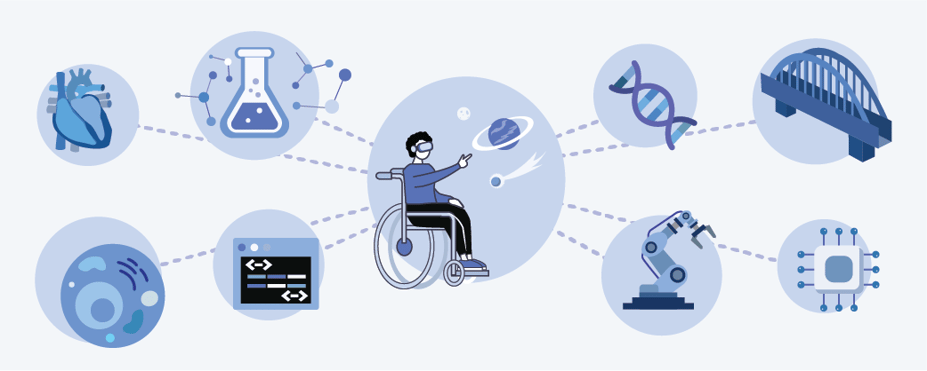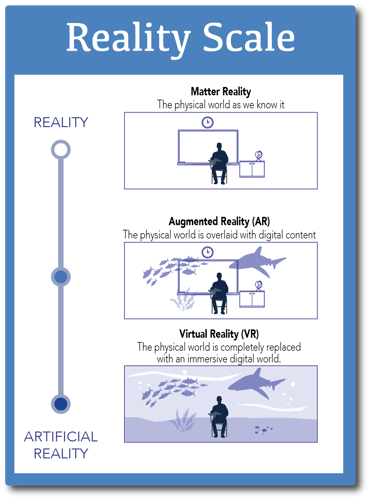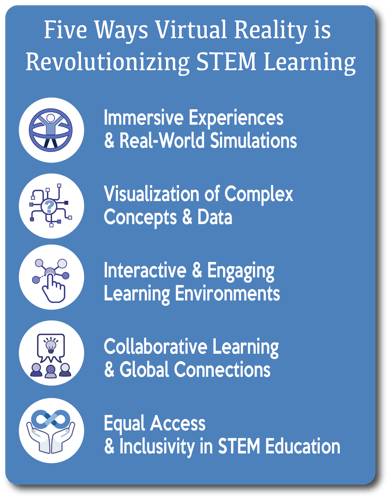
5 Easy Math Engagement Strategies for the Classroom
The news headlines are daunting. Math scores are down. School districts are scrambling to turn things around. And...
ALI Research Staff | Published August 07, 2023
As technology continues to change the educational landscape, it’s crucial for educators and decision-makers to be knowledgeable about cutting-edge solutions that can transform teaching and engage students. One of the most exciting new tools in this area is Virtual Reality.

Virtual reality (VR) has changed the game by providing immersive experiences that pique students' curiosity, improve their comprehension, and empower them to become active learners.
Prepare for an enlightening journey as we explore five ways VR is transforming STEM education, empowering schools to inspire a generation of STEM enthusiasts who are inquisitive, motivated, and prepared for the challenges of a rapidly changing world.
One way VR is transforming STEM education is by providing students with immersive experiences that take them to new worlds— both real and imagined.
Students can travel to far-off planets, visit the bottom of the ocean, or even go back in time to historical events thanks to the power of VR. These immersive learning opportunities offer a level of interest and excitement that conventional learning environments can’t match.
Virtual reality simulations allow students experiential learning and real-world application of principles.
For instance, students can perform surgery in a virtual operating room, conduct virtual research in a chemistry lab, or design and test engineering prototypes in a virtual setting.
These simulations allow students to practice critical thinking and problem-solving.

One benefit of VR simulations is that they give pupils a comfortable and structured setting to experiment. Students can repeat the simulations until they master them while making mistakes, learning from them, and improving.
This practical approach develops problem-solving and critical thinking abilities and a deeper understanding of core concepts.
Additionally, VR simulations broaden the assortment of real-world uses that students can investigate.
For instance, students can model real-world situations in disciplines like environmental science, aeronautical engineering, or even architectural design.
In this way, students develop important skills and gain useful experiences that prepare them for future professions in STEM.
Virtual reality has become a powerful tool for visualizing and comprehending difficult scientific ideas in the field of STEM education.
VR immerses students in complex phenomena that are typically difficult to visualize in conventional classroom settings.
With VR, scientific abstractions come to life, making it easier for students to understand difficult concepts.
For instance, students can experience a virtual voyage within the human body to learn about the circulatory system's intricate workings or observe molecular-level chemical processes.
Students gain a deeper comprehension of and greater retention of STEM fundamentals by actually experiencing these phenomena.
Additionally, VR makes it possible for students to interact with and manipulate big datasets in STEM subjects.
Through immersive data visualization, students can explore and evaluate complex information sets, such as astronomical data, genetic sequences, or climate data.
This interactive method of data exploration encourages analytical and critical thinking, enabling students to gain valuable insights.
A well-known platform that demonstrates the effectiveness of VR in data visualization is Tuva.
Students with access to this exceptional virtual environment can investigate real-world datasets. They can discover trends, make inferences, and build the data literacy skills necessary for success in the digital age by interacting with graphs, charts, and simulations in a virtual environment.
One major benefit of VR is its capacity to provide realistic simulations and scenarios that let students use their knowledge in practical settings.
VR allows students to engage in real-world STEM interactions, whether exploring Mars's surface or creating and testing engineering prototypes.
These dynamic and immersive settings enhance students' problem-solving abilities and foster collaboration among them, in addition to stimulating their curiosity.
PhET is one good example of a VR platform that exemplifies the best of interactive and interesting learning settings.
PhET provides a wide variety of virtual simulations in different STEM fields that let students investigate scientific phenomena, carry out experiments, and gain a deeper knowledge of ideas.
Students may actively connect with the curriculum through interactive features and lifelike simulations, improving their learning experience and memory retention.
VR's potential to facilitate collaboration is a key benefit. Students from around the world can work together on virtual platforms to solve challenging STEM problems.
Students can collaborate on challenges, discuss ideas, and gain knowledge from a variety of viewpoints, thanks to virtual reality. For instance, in a shared virtual environment, students can work together to create virtual models, carry out experiments, or design technical solutions.
In addition to improving collaboration and communication abilities, this collaborative method exposes students to other cultural backgrounds and ways of thinking.

VR also offers chances for students to communicate with experts, scientists, and professionals from numerous fields.
Students can tour scientific research facilities, travel to famous locations, and have dialogues with professionals from all over the world through virtual field trips and guest lectures.
These international links widen students' eyes, introduce them to various STEM vocations, and motivate them to follow their hobbies on a global scale.
VR's capacity to solve resource imbalances is a major benefit. Students can work in virtual labs to conduct simulations that mimic real-world investigations in schools without laboratory facilities or equipment.
This makes it possible for students to participate in experiential learning opportunities that were previously unavailable owing to financial or technical limitations.
Additionally, by accommodating a variety of learners, such as those with disabilities, VR encourages diversity in STEM education.
VR's immersive and interactive features support a variety of interaction modalities and learning styles. Visualizations, audio cues, and interactive components increase all students' comprehension and engagement.
Furthermore, VR can offer adaptive features and assistive technologies like text-to-speech, haptic feedback, and closed captioning that make STEM instruction more accessible to students with impairments.
By utilizing VR, educational institutions may develop inclusive learning environments where each student can actively participate and achieve success in the STEM fields.
All students have the chance to succeed in the digital era when schools leverage VR to its full potential for equitable access and inclusivity in STEM instruction.
VR lowers barriers, gives everyone access to information, and gives varied learners the tools they need to explore and succeed in STEM subjects.
The implementation of VR in STEM education has its own set of difficulties and concerns. To successfully integrate VR into their educational programs, we must be aware of these issues.
Here, we'll discuss typical obstacles and offer helpful advice and solutions to allow you to utilize VR in STEM education to its fullest potential.
The associated costs are one of the main issues when considering the use of VR.
The initial cost of VR technology, including the cost of headgear, software, and content, can be high. It’s crucial, however, to see this investment as a long-term commitment to STEM education.
Schools might lessen the price burden by investigating and examining affordable choices, looking for partnerships with VR producers, or thinking about leasing schemes.
Technical issues are another thing to consider. Schools must ensure that their technology, network bandwidth, and other infrastructure can handle VR applications.
Working together with IT departments or enlisting the support of VR specialists can help solve technical issues and guarantee a seamless installation process.
It's also essential to give teachers the necessary training and assistance if VR is to be successfully incorporated into STEM education.
Teachers should be prepared to successfully incorporate VR into their classrooms by having the requisite skills and expertise. Teachers can be equipped to navigate VR technology and make the most of it with the help of professional development programs, workshops, and ongoing support.
Challenges can also be reduced through collaboration and the exchange of best practices across educators and institutions. Schools can share resources, collaborate on VR initiatives, and learn from one another's experiences by creating a community of practice. This group effort encourages creativity and raises the overall standard of VR integration in STEM classrooms.
Last but not least, it's critical to match the goals and outcomes of the curriculum with the use of VR. VR should be used to improve and deepen student knowledge, not just for the sake of novelty.
Schools may ensure that VR experiences become an essential component of their STEM education program by incorporating them into existing lessons and matching them with specific learning objectives.
It's critical for school district staff to stay up to date on new trends and developments as virtual reality VR continues to transform STEM education.
Exciting advancements in VR technology, including enhanced hardware and software capabilities, are expanding the range of immersive learning opportunities.
The potential for VR in STEM education is growing, from virtual field excursions to sophisticated simulations.
VR has the potential to help students get ready for the workforce of the future in the future.
Students who have used VR in their STEM education will have essential skills and familiarity with cutting-edge tools as companies increasingly rely on technology and creativity.
Students can obtain practical experience and improve their problem-solving skills by participating in simulations and realistic job scenarios provided by virtual reality VR.
It's vital that school systems embrace VR's promise and consider how to include technology in curriculum design.
In a world that is changing quickly, educators may help kids succeed by remaining one step ahead of the curve. VR will become more and more important in STEM education as technology develops, enabling students to become the innovators and problem solvers of the future.

The news headlines are daunting. Math scores are down. School districts are scrambling to turn things around. And...

Math assessment in California is changing. What used to be a compliance exercise or reporting tool is now becoming a...

You know the moment: a student’s eyes light up when the science experiment fizzes or the math puzzle helps them...